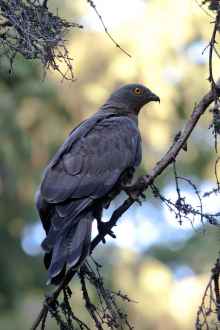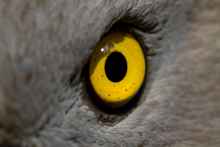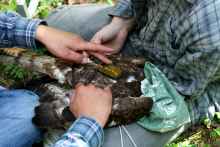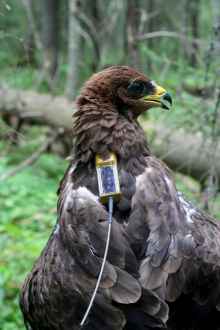Finnish Satellite Honey Buzzards
|
The knowledge of the migration routes and wintering grounds of Finnish honey buzzards is scarce since there are only a few ring recoveries. In addition, our knowledge on the movements of these hawks during the breeding season as well as on the African wintering grounds is limited. Answers to these study questions are sought in this study project that is funded by Kone Foundation and Pirttikylä Aktia Foundation. Leader of the study is Patrik Byholm (Novia University of Applied Sciences) in collaboration with Jari Valkama (Finnish Museum of Natural History) and Vincenzo Penteriani (Estación Biológica de Doñana, C.S.I.C., Spain). Read more about the backround » |
Funding:
|
|
Satellite Honey Buzzards
Click name to open the map
| Birds being tracked at the moment | |
|
No tracked individuals in 2020 |
|
| Birds tracked previously | |
| Päivi | Päivi got her transmitter at her nest in Vesilahti on August 13th 2013. The male was too timid to let himself get caught. The the pairs’ nest held two healthy chicks. |
| Aarne |
Aarne became the sixth adult honey buzzard to get equipped with a satellite transmitter. This took place at his nest in Vörå, Ostrobothnia on July 24 th 2012. Most likely Aarne faced a sudden death in the Central African Republic in the end of April 2014 since his transmitter then unexpectedly ceased to deliver information. |
| Annika |
Annika was harnessed with a transmitter near her nest in Hämeenkyrö, Tampere Region on the 5th August 2011. Female partner of Mikko. |
| Hans |
One of two chicks in a honey buzzard nest in Jurva, Southern Ostrobotnia. Hans got his satellite transmitter on August 2nd 2012. Becaude Hans's transmitter abruptly went quiet in the Congolesian rainforest in the end of March 2014 his life almost surely then came to an end, perhaps as the result of illness or predation. |
| Jaana |
As one of the two chicks from Jouko's brood, Jaana was harnessed on 28th July. Jaana died on her spring migration in West Sahara in May 2015. |
| Jouko |
A male honey buzzard from Lavia (western Finland) that was harnessed near its nest on 28th July 2011. The female of this breeding pair was too timid to get caught by the researchers. |
|
Kari had the honour to be the first Finnish breeding honey buzzard equipped with a satellite transmitter. He was harnessed with a GPS-Argos transmitter together with Tiina on 27th July 2011. Kari was the former partner of Tiina, but unfortunately he died in the African rain forest in January 2013. |
|
| Kirsi |
The single chick in a honey buzzard nest in Kristinestad, Ostrobothnia. Kirsi was harnessed with a satellite transmitter on August 10 th 2012. Unfortunately she was killed by the bullets of a hunter in Nigeria in mid-November 2012. |
| Lars |
The only chick of a honey buzzard pair breeding in Närpiö, Ostrobothnia was harnessed on 11th August 2011. Lars and at least his father represent the rare black colour morph. |
| Mikko | Mikko, Annika's male mate, was equipped near its nest in Hämeenkyrö, Tampere Region on the 5th August 2011. |
| Piff |
Chick of Kari and Tiina. Piff was harnessed with a transmitter on 6th August 2011. Piff's transmitter went quiet in the beginning of the spring of 2012 in the rainforest of Equatorial Guinea. Because the transimitter has remained quiet, it seems clear that Piff is dead. |
| Puff |
Chick of Kari and Tiina. Puff was harnessed with a transmitter on 6th August 2011. Died in the sand dunes of Mauretania on her first return migration in 2013. |
| Roosa |
One of the two chicks of Annika's and Mikko's brood, Roosa, was harnessed with a transmitter on the 5th August 2011. After Roosa's successful mifration from Hämeenkyrö to the Africa, her transmitter went mute towards the end of the winter of 2011-2012 in the rainforests of Congo. Because the transmitter has not initiated to generate new location data after that it seems evident Roosa is dead. |
| Tiina |
Tiina got her satellite transmitter at her home territory in Jurva, Southern Ostrobothnia on 27th July 2011. In the summer of 2013 Tiina formed pair with a new male after that her old spouse Kari had died. Then Tiina was also recaught and equipped with a new sort of transmitter that delivers GPS-data via a local antenna network on site in the breeding territory only. This means we get information about Tiina’s movements retrospectively when she returns to her breeding territory during the summer. |
| Lasse |
A male Honey Buzzard from Kokemäki, Satakunta Region has been monitored since 2010 in another project. |
Background: Satellite Honey Buzzards
|
The knowledge of the migration routes and wintering grounds of Finnish honey buzzards is scarce since the number of ring recoveries of this species is very low. However, according to the recoveries available, it is considered that Finnish honey buzzards migrate to tropical Africa taking one of the two routes: an eastern route via Black Sea and Israel or a western route by crossing the Mediterranean Sea via Italy or Malta. It is known that the wintering grounds are in the equator region in Africa, but there is no information how the buzzards move in these regions. The knowledge on movements during the breeding time in Finland is scarce as well. To get deeper insight into honey buzzard movement and migration ecology close to 40 Finnish honey buzzards have been harnessed with satellite transmitters in Western Finland starting in 2011. The transmitters are programmed to gather and send data according to a predetermined schedule. Transmitters weigh 22-27 grams and they run with solar power. With good luck they might be functional 3–5 years. The whereabouts of some of the transmitter-equipped birds can be followed on this web-page. Patrik Byholm Jari Valkama |
   |
Gilda the Honey Buzzard
In addition to the honey buzzards’ whose whereabouts can be followed on our web-pages, we last summer also harnessed a few buzzards’ whose movements we have chosen not to publish online. But now one of these birds has been involved in such an extraordinary chain of events that we thought it is our duty to tell it in public. The young female honey buzzard Gilda, daughter to Annika and Mikko, was equipped with a satellite transmitter at her nest in Hämeenkyrö in the beginning of August. As Kirsi and Hans also Gilda initiated her autumn migration in the middle of September. Even though Gilda needed a little more time than the rest of the young buzzards to reach into tropical Africa, she successfully managed to cross Sahara and reached Sahel in Mali and Niger in the beginning of November. With this all seemed to be in good order for the first overwintering in Africa. But when we acquainted us with the package of coordinates that arrived in the morning of November 9 th, we got suspicious: since November 6 th Gilda (or rather her transmitter) had remained motionless in the village of Dessa at the shores of the river Niger in the Tillabéri district ca. 250 km NW of Niamey, the capital in the Republic of Niger. Was Gilda dead?
We did not have to wonder over Gilda’s faith very long. When later opening the email client two messages had arrived from Niger that confirmed our suspicions, one from Ali Laoual Abagana state officer in response for game management and bird protection at the Ministry of Water- and Environment, another from Mohamadou Souley Seini game management chief at the regional environmental administration in the Tillabéri district. According to the information they could deliver, Gilda had been found around Dessa unable to fly and was then taken into captivity for treatment later just to die on November 9 th. Thus, apparently the flight over Sahara was too laborious for Gilda which was why she succumbed just when she had completed the most demanding part of the autumn migration. Given that there before this have been only 25 ring recoveries of Finnish honey buzzards from Africa south of the Sahara since bird ringing activity started in Finland in 1913 this story constitutes an important addition to the understanding of which factors govern the Finnish honey buzzard population. At the same time it also constitutes a extraordinary example of which possibilities animal satellite tracking in combination with the use of Internet can provide in establishing new contacts between countries, a prerequisite for the development of international conservation measures of migratory birds. Gilda’s death served a purpose!




